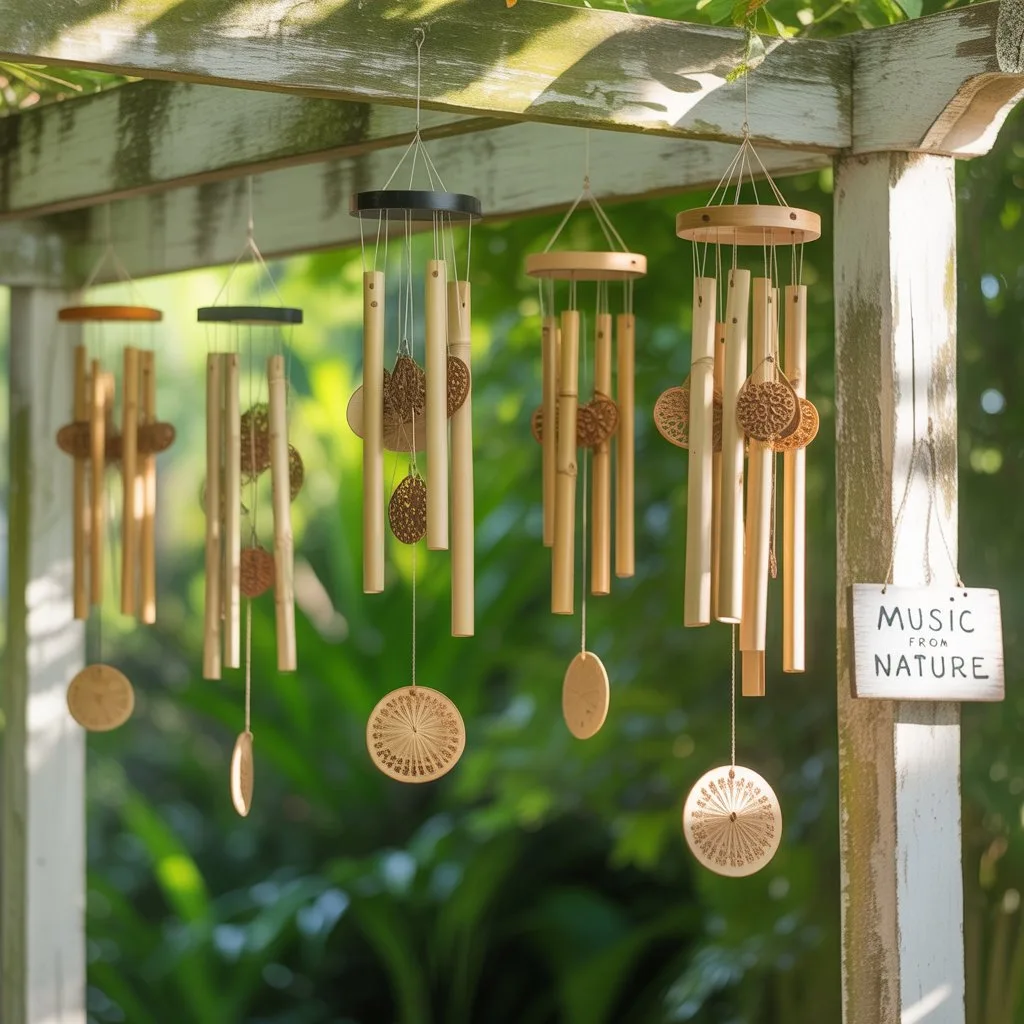Creating DIY bamboo and seed wind chimes is a delightful way to blend creativity, sustainability, and nature into your outdoor space. Handmade wind chimes offer a unique aesthetic while producing gentle, soothing sounds that enhance the ambiance of any garden, patio, or balcony. By using natural materials like bamboo, seeds, and twine, you can craft a beautiful, eco-friendly decoration that is both functional and visually appealing.

Bamboo wind chimes have a long-standing tradition across many cultures, known for their melodic tones and natural durability. Incorporating seeds and other botanical elements adds texture, color, and symbolic meaning. Seeds can represent growth, life, and new beginnings, making these wind chimes not only a decorative item but also a meaningful addition to your garden.
Selecting Materials for Natural Wind Chimes
The key to successful DIY bamboo and seed wind chimes is choosing high-quality, sustainable materials. Bamboo is an excellent choice due to its light weight, strength, and natural resonance. Select bamboo pieces that are dry and free from cracks. They can vary in length to create different tones when they strike each other.
Seeds and small pods add visual appeal and subtle percussive sounds. Consider using seeds from sunflowers, acorns, or other local plants. You can also incorporate small shells, beads, or wooden discs to enhance both aesthetics and sound variety. Eco-friendly twine, hemp cord, or natural jute are perfect for stringing the components together, as they blend seamlessly with natural elements and withstand outdoor conditions.
Tools and Safety Precautions
Creating wind chimes requires basic tools: a small saw or pruners to cut bamboo, a drill for making holes, scissors, and a ruler or measuring tape. A workspace with adequate ventilation and a stable surface ensures safety and accuracy.
When handling sharp tools, always wear protective gloves and eyewear. Bamboo can splinter, so sanding the cut edges smooths them and prevents injuries. Using appropriate knots and secure attachments is essential to ensure the wind chime withstands wind and weather.
Preparing Bamboo Tubes
Cutting bamboo to the desired lengths is one of the most important steps, as the length of each tube influences the sound it produces. Longer tubes create deeper, resonant tones, while shorter tubes generate higher-pitched sounds. Using a ruler or measuring tape, cut bamboo pieces at varying lengths to create a harmonious arrangement of tones.
Drill small holes near the top of each bamboo tube for threading twine. Sand the edges of the drilled holes to prevent fraying and ensure durability. Proper spacing and alignment of holes are crucial for balanced movement and pleasing sound.
Selecting and Preparing Seeds
Choose seeds or small botanical elements that are lightweight and visually interesting. Large seeds may be too heavy for delicate wind chimes, while tiny seeds may not be easily visible. Clean seeds thoroughly and let them dry completely before incorporating them to prevent mold or decay.
For added stability, you can thread seeds onto small wooden discs or beads, creating clusters that produce subtle sounds when they move or strike each other. Combining different seeds and natural elements adds visual texture and diversity to the wind chime design.
Assembling the Wind Chime
Begin by cutting twine into multiple lengths, one for each bamboo tube. Tie a secure knot at the end of each string and thread it through the pre-drilled hole in the bamboo tube. Ensure knots are tight to prevent slippage and uneven hanging.
Arrange bamboo tubes in descending order or varied patterns, depending on the desired sound arrangement. Attach seeds, beads, or other decorative elements along each string, spacing them evenly. You can create symmetrical or asymmetrical designs, depending on aesthetic preference.
For the top support, use a wooden ring, bamboo slice, or sturdy piece of driftwood. Tie each string to the support securely, adjusting lengths as needed to allow free movement of bamboo tubes. Check for balanced weight distribution to prevent tilting or twisting.
Enhancing Sound and Aesthetics
The charm of bamboo wind chimes lies in their gentle, melodic sounds. Experiment with spacing, tube length, and placement to achieve the desired resonance. Hanging the wind chime in a location with consistent, mild airflow allows it to produce a continuous, pleasant tone.
You can decorate bamboo tubes with natural paints, wood stain, or carved patterns for added visual appeal. Avoid synthetic coatings that may wear off in outdoor conditions or release harmful chemicals. Natural decorations maintain the eco-friendly essence of the project.
Placement and Hanging Tips
Optimal placement enhances both sound and visual impact. Hang wind chimes from a tree branch, pergola, porch, or balcony railing. Ensure there is space around the chime to move freely without striking walls or other objects.
Height and orientation affect sound. Experiment with different positions to find the perfect balance between audible tones and aesthetic presence. Consider sun exposure and weather conditions to protect delicate elements from damage.
Seasonal and Symbolic Variations
You can adapt wind chime designs to reflect seasons or symbolic meanings. Spring-inspired chimes may include bright-colored seeds or flower petals, while autumn designs can incorporate acorns, pinecones, or dried leaves. Seasonal variations provide ongoing creative opportunities and allow wind chimes to complement evolving garden themes.
Herbal or aromatic seeds, such as lavender or rosemary, can add subtle fragrance to the wind chime, enhancing the sensory experience. These elements create a multi-sensory decoration that combines visual, auditory, and olfactory enjoyment.
Maintaining Bamboo and Seed Wind Chimes
Proper care ensures longevity. Occasionally clean bamboo tubes with a damp cloth to remove dirt or dust. Avoid prolonged exposure to direct rain, which can degrade bamboo and natural twine over time. Treating bamboo with a light coat of natural oil, such as linseed or coconut oil, enhances weather resistance.
Seeds and decorative elements may require occasional adjustment to maintain balance and prevent tangling. Regular inspection keeps the wind chime functional and aesthetically pleasing for years.
Educational and Therapeutic Benefits
Making DIY bamboo and seed wind chimes provides an educational experience, teaching principles of sound, balance, and design. Children and adults alike can explore natural materials, learn about different plant seeds, and experiment with auditory effects.
The process is also therapeutic, offering a calming, mindful activity that promotes focus, creativity, and connection with nature. Hanging the finished wind chime in your garden creates a visual and auditory reminder of the satisfaction and relaxation derived from hands-on crafting.
Expanding Your Craft Skills
Once comfortable with a basic bamboo and seed wind chime, you can experiment with more intricate designs. Multiple layers of bamboo tubes, varied seed clusters, or mixed natural materials can create complex chimes with unique tonal qualities.
Incorporating recycled materials, such as driftwood or reclaimed bamboo, adds sustainability and character. Exploring different natural textures, lengths, and arrangements encourages ongoing creativity and refinement of craft techniques.
Creating bamboo and seed wind chimes fosters a sense of accomplishment, creativity, and eco-consciousness. Each chime is unique, reflecting personal design choices and the natural beauty of materials. The gentle tones produced by bamboo and seeds create an inviting and serene garden atmosphere.
Engaging in this craft encourages sustainable living, hands-on learning, and mindful enjoyment of natural sounds. Sharing creations with friends, family, or local communities spreads inspiration and promotes environmentally friendly practices.
DIY bamboo and seed wind chimes are a perfect combination of aesthetics, sustainability, and functionality. By selecting natural materials, exploring creative arrangements, and experimenting with sound, you can craft a decorative piece that enhances your garden’s beauty and ambiance while celebrating eco-friendly craftsmanship.
Lucas Hartman is a DIY enthusiast and sustainability advocate focused on natural crafts and eco-friendly home décor. With a background in arts and design, Lucas creates tutorials that help families and hobbyists transform everyday recycled or organic materials into beautiful, functional projects.
